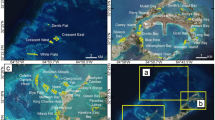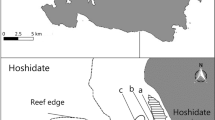Abstract
Hawksbill sea turtles, Eretmochelys imbricata, are closely associated with coral reef and other hard-bottom habitats. Seagrass pastures are peripheral habitats for Caribbean hawksbills. With the decline in quality and quantity of coral reefs, seagrass habitats may become more important for hawksbills. We use data from a 30-year mark-recapture study of hawksbills and green turtles, Chelonia mydas, in the southern Bahamas to assess the quality of a seagrass habitat for hawksbills. Size distribution, residence times, and body condition index for the seagrass hawksbill aggregation are similar to those of hawksbill aggregations over Caribbean reefs. Somatic growth rates of seagrass hawksbills are in the upper range of those reported for reef hawksbills. Based on these parameters, peripheral seagrass habitats can support healthy, productive hawksbill aggregations. During the 30-year study, a sixfold variation in green turtle density in the study area did not affect the productivity or body condition of hawksbills.








Similar content being viewed by others
References
Barrow LM, Bjorndal KA, Reich KJ (2008) Effects of preservation method on stable carbon and nitrogen isotope values. Physiol Biochem Zool 81:688–693
Bellini C, Sanches TM, Formia A (2000) Hawksbill turtle tagged in Brazil captured in Gabon, Africa. Mar Turt Newsl 87:11–12
Bjorndal KA (1980) Nutrition and grazing behavior of the green turtle, Chelonia mydas. Mar Biol 56:147–154
Bjorndal KA (1990) Digestibility of the sponge Chondrilla nucula in the green turtle, Chelonia mydas. Bull Mar Sci 47:567–570
Bjorndal KA (1997) Foraging ecology and nutrition of sea turtles. In: Lutz PL, Musick JL (eds) The biology of sea turtles. CRC Press, Boca Raton, pp 199–231
Bjorndal KA, Bolten AB (1988) Growth rates of immature green turtles, Chelonia mydas, on feeding grounds in the southern Bahamas. Copeia 1988:555–564
Bjorndal KA, Bolten AB (1989) Comparison of straight-line and over-the-curve measurements for growth rates of green turtles, Chelonia mydas. Bull Mar Sci 45:189–192
Bjorndal KA, Bolten AB (2008) Annual variation in source contributions to a mixed stock: implications for quantifying connectivity. Mol Ecol 17:2185–2193
Bjorndal KA, Carr A, Meylan AB, Mortimer JA (1985) Reproductive biology of the hawksbill, Eretmochelys imbricata, at Tortuguero, Costa Rica, with notes on the ecology of the species in the Caribbean. Biol Conserv 34:353–368
Bjorndal KA, Bolten AB, Chaloupka MY (2000) Green turtle somatic growth model: evidence for density dependence. Ecol Appl 10:269–282
Bjorndal KA, Bolten AB, Dellinger T, Delgado C, Martins HR (2003) Compensatory growth in oceanic loggerhead sea turtles: response to a stochastic environment. Ecology 84:1237–1249
Bjorndal KA, Bolten AB, Chaloupka MY (2005) Evaluating trends in abundance of immature green turtles, Chelonia mydas, in the Greater Caribbean. Ecol Appl 15:304–314
Bjorndal KA, Clovis T, Reich KJ, Alkins G, Eliazar PJ, Bolten AB (2008) Juvenile hawksbill tagged in the Bahamas nests in Tobago. Mar Turt Newsl 122:10–11
Blumenthal JM, Austin TJ, Bell CDL, Bothwell JB, Broderick AC, Ebanks-Petrie G, Gibb JA, Luke KE, Olynik JR, Orr MF, Solomon JL, Godley BJ (2009) Ecology of hawksbill turtles, Eretmochelys imbricata, on a western Caribbean foraging ground. Chelonian Conserv Biol 8:1–10
Bolger T, Connolly PL (1989) The selection of suitable indices for the measurement and analysis of fish condition. J Fish Biol 34:171–182
Boulon RH Jr (1994) Growth rates of wild juvenile hawksbill turtles, Eretmochelys imbricata, in St. Thomas, United States Virgin Islands. Copeia 1994:811–814
Bowen BW, Grant WS, Hillis-Starr Z, Shaver DJ, Bjorndal KA, Bolten AB, Bass AL (2007) Mixed-stock analysis reveals the migrations of juvenile hawksbill turtles (Eretmochelys imbricata) in the Caribbean Sea. Mol Ecol 16:49–60
Carr A (1980) Some problems of sea turtle ecology. Am Zool 20:489–498
Chaloupka MY, Limpus CJ (1997) Robust statistical modelling of hawksbill sea turtle growth rates (Southern Great Barrier Reef). Mar Ecol Prog Ser 146:1–8
Chaloupka M, Bjorndal KA, Balazs GH, Bolten AB, Ehrhart LM, Limpus CJ, Suganuma H, Troëng S, Yamaguchi M (2008) Encouraging outlook for recovery of a once severely exploited marine megaherbivore. Glob Ecol Biogeogr 17:297–304
Channell R, Lomolino MV (2000) Dynamic biogeography and conservation of endangered species. Nature 403:84–86
Diez CE, van Dam RP (2002a) Hawksbill turtle reproduction at Mona Island, Puerto Rico: 1989–1999. In: Mosier A, Foley A, Brost B (compilers) Proceedings of the twentieth annual symposium on sea turtle biology and conservation. NOAA Technical Memorandum NMFS-SEFSC-477, pp 136–138
Diez CE, van Dam RP (2002b) Habitat effect on hawksbill turtle growth rates on feeding grounds at Mona and Monito Islands, Puerto Rico. Mar Ecol Prog Ser 234:301–309
Diez CE, Vélez-Zuazo X, van Dam RP (2003) Hawksbill turtles in seagrass beds. Mar Turt Newsl 102:8–10
Godley BJ, Broderick AC, Hays GC (2001) Nesting of green turtles (Chelonia mydas) at Ascension Island, South Atlantic. Biol Conserv 97:151–158
Green AJ (2001) Mass/length residuals: measures of body condition or generators of spurious results? Ecology 82:1473–1483
Grossman A, Bellini C, Fallabrino A, Formia A, Mba JM, Mba JN, Obama C (2007) Second TAMAR-tagged hawksbill recaptured in Corisco Bay, West Africa. Mar Turt Newsl 116:26
Hayes JP, Shonkwiler JS (2001) Morphometric indicators of body condition: worthwhile or wishful thinking? In: Speakman JR (ed) Body composition analysis of animals: a handbook of non-destructive methods. Cambridge University Press, Cambridge, pp 8–38
IUCN (2002) Hawksbill turtles in the Caribbean region: basic biological characteristics and population status. CITES Wider Caribbean range state hawksbill turtle dialogue meetings. http://www.cites.org. Accessed 20 June 2009
IUCN (2009) The IUCN red list of threatened species. http://www.iucnredlist.org. Accessed 15 June 2009
Jackson JBC, Kirby MX, Berger WH, Bjorndal KA, Botsford LW, Bourque BJ, Bradbury RH, Cooke R, Erlandson J, Estes JA, Hughes TP, Kidwell S, Lange CB, Lenihan HS, Pandolfi JM, Peterson CH, Steneck RS, Tegner MJ, Warner RR (2001) Historical overfishing and the recent collapse of coastal ecosystems. Science 293:629–638
Jones GP, McCormick MI, Srinivasan M, Eagle JV (2004) Coral decline threatens fish biodiversity in marine reserves. Proc Natl Acad Sci 101:8251–8253
León YM, Bjorndal KA (2002) Selective feeding in the hawksbill turtle, an important predator in coral reef ecosystems. Mar Ecol Prog Ser 245:249–258
León YM, Diez CE (1999) Population structure of hawksbill turtles on a foraging ground in the Dominican Republic. Chelonian Conserv Biol 3:230–236
Martínez del Rio C, Wolf BO (2005) Mass balance models for animal isotopic ecology. In: Starck MA, Wang T (eds) Physiological and ecological adaptations to feeding in vertebrates. Science Publishers, Enfield, pp 141–174
Meylan A (1988) Spongivory in hawksbill turtles: a diet of glass. Science 239:393–395
Meylan AB (1999) International movements of immature and adult hawksbill turtles (Eretmochelys imbricata) in the Caribbean region. Chelonian Conserv Biol 3:189–194
Meylan AB, Donnelly M (1999) Status justification for listing the hawksbill turtle (Eretmochelys imbricata) as critically endangered on the 1996 IUCN Red List of Threatened Animals. Chelonian Conserv Biol 3:200–224
Mora C (2008) A clear human footprint in the coral reefs of the Caribbean. Proc R Soc B 275:767–773
Moran KL, Bjorndal KA (2005) Simulated green turtle grazing affects structure and productivity of seagrass pastures. Mar Ecol Prog Ser 305:235–247
Moran KL, Bjorndal KA (2007) Simulated green turtle grazing affects nutrient composition of the seagrass Thalassia testudinum. Mar Biol 150:1083–1092
Mortimer JA, Donnelly M (2007) Marine Turtle Specialist Group 2007 IUCN Red List status assessment hawksbill turtle (Eretmochelys imbricata). http://www.iucn-mtsg.org/red_list/ei/index.shtml. Accessed 17 June 2009
Mortimer JA, Collie J, Jupiter T, Chapman R, Liljevik A, Betsy B (2003) Growth rates of immature hawksbills (Eretmochelys imbricata) at Aldabra Atoll, Seychelles (Western Indian Ocean). In: Seminoff JA (compiler) Proceedings of the twenty-second annual symposium on sea turtle biology and conservation. NOAA Technical Memorandum NMFS-SEFSC-503, pp 247–248
Namgail T, Fox JL, Bhatnagar YV (2007) Habitat shift and time budget of the Tibetan argali: the influence of livestock grazing. Ecol Res 22:25–31
Naves J, Wiegand T, Revilla E, Delibes M (2003) Endangered species constrained by natural and human factors: the case of brown bears in northern Spain. Conserv Biol 17:1276–1289
Newsome SD, Martínez del Rio C, Bearhop S, Phillips DL (2007) A niche for isotopic ecology. Front Ecol Environ 5:429–436
Owen M (1981) Abdominal profile–a condition index for wild geese in the field. J Wildl Manage 45:227–230
Pandolfi JM, Bradbury RH, Sala E, Hughes TP, Bjorndal KA, Cooke RG, McArdle C, McClenachan L, Newman MJH, Paredes G, Warner RR, Jackson JBC (2003) Global trajectories of the long-term decline of coral reef ecosystems. Science 301:955–958
Reich KJ, Bjorndal KA, Bolten AB (2007) The ‘lost years’ of green turtles: using stable isotopes to study cryptic lifestages. Biol Lett 3:712–714
Reich KJ, Bjorndal KA, Martínez del Rio C (2008) Effects of growth and tissue type on the kinetics of 13C and 15N incorporation in a rapidly growing ectotherm. Oecologia 155:651–663
Ricker WE (1975) Computation and interpretation of biological statistics of fish populations. Bull Fish Res Board Can 191:1–382
Roark AM, Leeuwenburgh C, Bjorndal KA, Bolten AB (2009a) Biochemical indices as correlates of recent growth in juvenile green turtles (Chelonia mydas). J Exp Mar Biol Ecol 376:59–67
Roark AM, Bjorndal KA, Bolten AB (2009b) Compensatory responses to food restriction in juvenile green turtles (Chelonia mydas). Ecology 90:2524–2534
Sanches TM, Bellini C (1999) Juvenile Eretmochelys imbricata and Chelonia mydas in the Archipelago of Fernando de Noronha, Brazil. Chelonian Conserv Biol 3:308–311
Schulte-Hostedde AI, Zinner B, Millar JS, Hickling GJ (2005) Restitution of mass–size residuals: validating body condition indices. Ecology 86:155–163
Whiting SD, Guinea ML (1998) A large population of slow growing hawksbills: preliminary results from a wild foraging population in Fog Bay, Northern Territory. In: Epperly SP, Braun J (compilers) Proceedings of the seventeenth annual sea turtle symposium. NOAA Technical Memorandum NMFS-SEFSC-415, pp 104–107
Wildman EE, Jones IGM, Wagner PE, Boman RL, Troutt HF Jr, Lesch TN (1982) A dairy cow body condition scoring system and its relationship to selected production characteristics. J Dairy Sci 65:495–501
Williams SL (1988) Thalassia testudinum productivity and grazing by green turtles in a highly disturbed seagrass bed. Mar Biol 98:447–455
Wulff JL (2006) Rapid diversity and abundance decline in a Caribbean coral reef sponge community. Biol Conserv 127:167–176
Acknowledgments
We thank K. Reich for conducting the stable isotope analyses, J. Blumenthal for sharing raw data, and P. Eliazar for database management. The long-term study at UCR is in cooperation with the Bahamas National Trust (BNT) and would not have been possible without the assistance of the BNT wardens on Great Inagua: H. Nixon, R. Burrows, J. Nixon, S. Nixon, and T. Major. We are grateful to the Bahamas Department of Marine Resources for their support and permits to conduct research in the Bahamas. The research has been funded by the Disney Worldwide Conservation Fund, US National Marine Fisheries Service, National Fish and Wildlife Foundation, and the Caribbean Conservation Corporation. Morton Bahamas Ltd., the US Coast Guard, and the people of Mathew Town, Inagua, have provided invaluable logistic support. All work was conducted in compliance with the Institutional Animal Care and Use Committee, University of Florida.
Author information
Authors and Affiliations
Corresponding author
Additional information
Communicated by R. Lewison.
Rights and permissions
About this article
Cite this article
Bjorndal, K.A., Bolten, A.B. Hawksbill sea turtles in seagrass pastures: success in a peripheral habitat. Mar Biol 157, 135–145 (2010). https://doi.org/10.1007/s00227-009-1304-0
Received:
Accepted:
Published:
Issue Date:
DOI: https://doi.org/10.1007/s00227-009-1304-0




